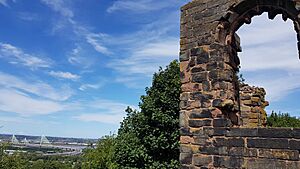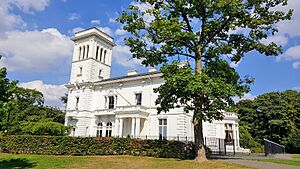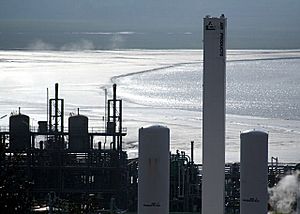Borough of Halton facts for kids
Quick facts for kids
Borough of Halton
|
||
|---|---|---|
|
Borough and unitary authority
|
||
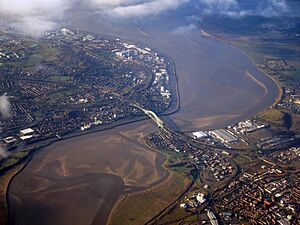
|
||
|
||
| Motto(s): | ||
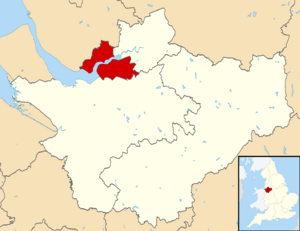
Halton shown within Cheshire
|
||
| Sovereign state | United Kingdom | |
| Country | England | |
| Region | North West | |
| Ceremonial county | Cheshire | |
| City region | Liverpool | |
| Incorporated | 1 April 1974 | |
| Unitary authority | 1 April 1998 | |
| Named for | Barony of Halton | |
| Administrative HQ | Municipal Building, Widnes | |
| Government | ||
| • Type | Unitary authority | |
| • Body | Halton Borough Council | |
| Area | ||
| • Total | 30 sq mi (90 km2) | |
| • Land | 30.54 sq mi (79.09 km2) | |
| Area rank | 242nd | |
| Population
(2005 est.)
|
||
| • Total | 129,410 | |
| • Rank | 178th | |
| Ethnicity (2021) | ||
| • Ethnic groups |
List
|
|
| Religion (2021) | ||
| • Religion |
List
58.6% Christianity
35.2% no religion 0.6% Islam 0.3% Hinduism 0.2% Buddhism 0.1% Sikhism 0.0% Judaism 0.4% other 4.6% not stated |
|
| Time zone | UTC+0 (GMT) | |
| • Summer (DST) | UTC+1 (BST) | |
| Postcode areas |
|
|
| Dialling codes |
|
|
| ISO 3166 code | GB-HAL | |
| GSS code | E06000006 | |
Halton is a special area in North West England. It has a "borough" status, which means it's a local government district. Halton was created in 1974. It includes the towns of Runcorn and Widnes. It also has smaller areas like Daresbury and Hale.
Since 1998, Halton has been a "unitary authority." This means its local council, Halton Borough Council, handles most local services. These services include things like schools, roads, and waste collection. Since 2014, Halton has been part of the Liverpool City Region. This helps the towns work together on bigger projects.
Halton is surrounded by other areas. These include Liverpool, Knowsley, St Helens, Warrington, and Cheshire West and Chester.
Contents
Discover Halton's Past
The River Mersey is an important natural border. It used to separate two old counties: Lancashire to the north and Cheshire to the south. Before 1974, Widnes was part of Lancashire. Runcorn was part of Cheshire.
In 1974, a big change happened. The Local Government Act 1972 created new local areas. Widnes and Runcorn were brought together. They formed the new district of Halton. The name "Halton" comes from an old area called the Barony of Halton. This old area had land on both sides of the river.
On April 1, 1998, Halton became a "unitary authority." This means its local council became independent. It now manages most local services on its own. However, it still works with Cheshire Police and Cheshire Fire and Rescue Service. Halton is also part of the Liverpool City Region. This helps it work with nearby cities like Liverpool.
Halton's People and Places
How Many People Live in Halton?
Halton is home to about 129,410 people. The borough was created in 1974. But we can look at old records to see how the population has changed.
| Year | Population | Change as % |
|---|---|---|
| 1801 | 6,460 | — |
| 1811 | 7,491 | +16.0% |
| 1821 | 8,962 | +19.6% |
| 1831 | 10,918 | +21.8% |
| 1841 | 13,364 | +22.4% |
| 1851 | 16,296 | +21.9% |
| 1861 | 17,678 | +8.5% |
| 1871 | — | — |
| 1881 | 46,181 | — |
| 1891 | 58,042 | +25.7% |
| 1901 | — | — |
| 1911 | 56,656 | — |
| 1921 | 61,977 | +9.4% |
| 1931 | 64,979 | +4.8% |
| 1941 | — | — |
| 1951 | 80,072 | — |
| 1961 | 82,119 | +2.6% |
| 1971 | 99,749 | +21.5% |
| 1981 | 129,187 | +29.5% |
| 1991 | 128,525 | -0.5% |
| 2001 | 118,242 | -8.0% |
| 2011 | 125,746 | +6.3% |
| 2021 | 128,478 | +2.2% |
What Religions are Practiced?
In 2021, most people in Halton (58.6%) said they were Christian. This is higher than the average for England. About 35.2% said they had no religion. A small number of people followed other religions like Islam, Hinduism, or Buddhism.
Who Lives in Halton?
In 2021, most Halton residents (96.5%) identified as White. About 3.5% were from other ethnic backgrounds. Also, 95.2% of people living in Halton were born in the United Kingdom.
How Halton is Governed
Halton Borough Council is in charge of local government in Halton. The Labour Party has been in control of the council since it started in 1974.
Halton is also part of the Liverpool City Region. This means it works with five other local councils in the area. They work together on important issues that affect the whole region.
Halton is divided into two areas for national elections. These are called Widnes and Halewood and Runcorn and Helsby. Both areas are currently represented by members of the Labour Party.
Halton's Economy and Jobs
In 2021, Halton's economy was worth about £4.0 billion. This is a measure of all the goods and services produced. Halton has a strong economy. It is known for its industries, science, and logistics (moving goods).
In 2022, there were about 67,000 jobs in Halton. Many of these jobs are full-time. Halton has more jobs in industry and science compared to other parts of Great Britain.
The number of people working in Halton is high. In 2023, the average weekly wage for full-time workers in Halton was £664. This is a good wage for the region.
Media and Communication
Television
People in Halton can watch TV from BBC North West and ITV Granada. These channels bring local news and shows to the area.
Radio
There are several radio stations you can listen to in Halton:
- BBC Radio Merseyside
- Heart North West
- Smooth North West
- Capital North West & Wales
- Greatest Hits Radio Liverpool & The North West
- Hits Radio Liverpool
- Dee Radio
- Halton Community Radio, which is a local station.
Newspapers
You can read local news in these newspapers:
- The Runcorn & Widnes Weekly News
- Runcorn and Widnes World
Halton's Twin Towns
Halton has special friendships with towns in other countries. These are called "twin boroughs" or "sister cities."
 Marzahn-Hellersdorf, Berlin, Germany (since 1993)
Marzahn-Hellersdorf, Berlin, Germany (since 1993) Ústí nad Labem, Czech Republic (since 1993)
Ústí nad Labem, Czech Republic (since 1993) Leiria, Portugal (since 1997)
Leiria, Portugal (since 1997) Tongling, China (since 1997)
Tongling, China (since 1997)
These friendships involve many exchanges. For example, Halton residents once sent 1,000 English books to a university in the Czech Republic. An old Halton bus was even sent to the Czech Republic to celebrate public transport there. Students from Halton helped build a crazy golf course in Berlin.
You can see signs of these friendships around Halton. Some roads are named after the twin towns, like Leiria Way in Runcorn. There's also a Chinese friendship garden at Runcorn Town Hall. It even has a bronze statue from Tongling, China.



